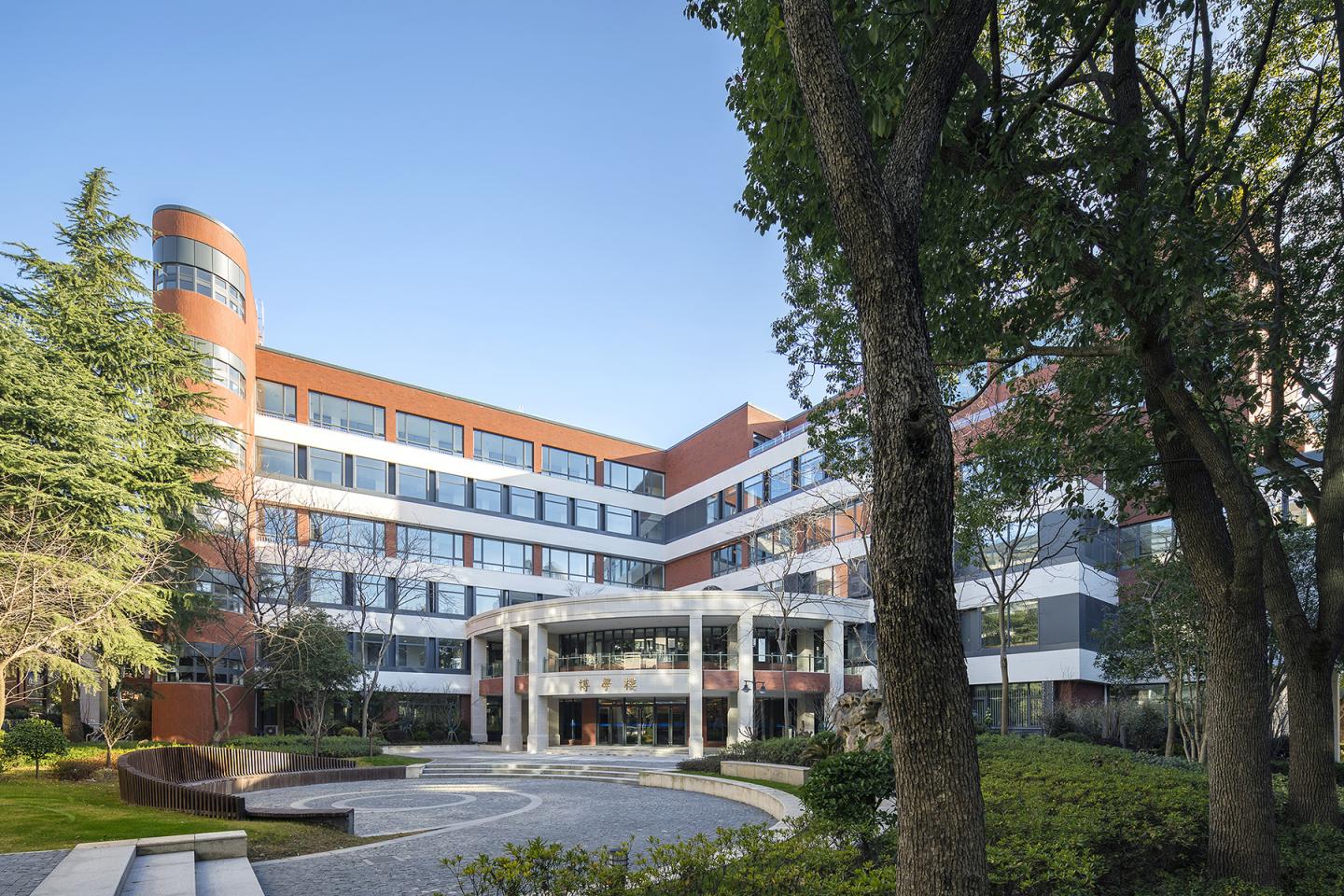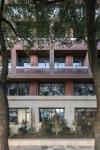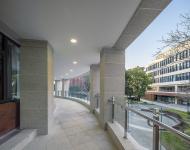The renovation of an old building, will often encounter a couple of technical challenges such as the structural system, cost control(material pricing) and also the industries standard depending on the type of architecture. On the other hand, the aesthetics and usage of the building play a strong role in our design; but these factors are not just challenges but also a key point on how we choose to approach the design.
Boxue Building and cultural tradition of Fudan with time-honored history
The High School Affiliated to Fudan University, established in 1950, grew out of the Speed-up School for Workers and Peasants Affiliated to Fudan University (1953), the Labor High School (1957), and the Preparatory School for Workers and Peasants of Fudan University. The high school, named the High School Affiliated to Fudan University in 1962, is a Shanghai experimental demonstration senior high school under the co-direction of Shanghai Education Commission and Fudan University. As a prestigious school with time-honored history, it has also formed a unique culture of its own, especially the red brick being a hallmark of the age-old academic culture.
A coherent facade designed at the same time
- The west and north facades where tradition and modernity intersect -
To echo the other two "red brick" teaching buildings on campus and cater to its long history and pioneering spirit of the high school, we selected red tapestry bricks as the base and white stone lines among them decorated with dark gray to change the monotonous facade of the teaching building and bring new vitality into this time-honored school.
While transforming the facade, we also carried out a micro-renovation of part of the space to enhance the image of the teaching building and improve the user experience; more gray spaces are opened for socializing and more sunlight are introduced in the teaching building to enhance the user experience.
- Coherent and integrated south facade -
Because of its square shape, the Boxue Building is higher than the nearby Danhua Building in terms of visual experience. White aluminum panels and white square-hole perforated aluminum panels are added to the fourth floor as a line to extend the white lines of the Danhua Building, making the overall image of the south facade uniform and optimized. In addition, the third and fourth floors are highlighted with a mass volume to enhance the facade changes and the 48 air conditioner external unit originally distributed on each floor are placed behind the perforated aluminum panels to make the facade more clean and tidy.
- Trendy and cascaded east facade -
The east facade is the main street-facing facade of Boxue Building, which "communicates" with the surrounding buildings, highlighting the integration of the new and the old languages. The red bricks with a sense of history are used to build a trendy and cascaded facade; and the perforated metal plates go well with the rhythm of the facade while keeping the messy and random arrangement of the air conditioner external unit out of sight.
- Lightsome and orderly connecting corridor -
The corridor connecting Danhua Building and Boxue Building is an important traffic node in the school, which satisfies the efficient connection between the teaching buildings; but the simple curved sun roof that was originally built is not only leaking, but also dusty, largely diminishing the practicability and the appearance. Therefore, we changed the form of the original roof by re-arranging the drainage and adding sound insulation materials to the suspended ceiling for noise reduction; given the overall facade effect of the campus, the white perforated panel is attached to the outside, connecting the two teaching buildings with light "rhythm".
"Weight replacement" — New facade with a sense of history and modernity
At the beginning of the facade design for Boxue Building, the feasibility of the load was taken into consideration. In order not to add additional load to the teaching building, we removed some of the heavy window wall and cantilever slab to reduce its own weight, and then built the structure with relatively light cement fiberboard and perforated aluminum panels as the finishing material of the facade. In addition to the decorous feeling and sense of history brought by the red bricks, such finishing material brings the building a touch of agility and modernity.
- Cement fiberboard -
There are two main types of cement fiberboard applied to the project. One is the white fiberboard mimicking stone block texture, which is applied to the east and north facades; and the other is the red fiberboard mimicking brick texture, which is applied to the south facade. In addition, we hide many air-conditioning pipelines and downspouts originally exposed outside in the spaces required for fiberboard keel structure installation. Such material is with the appearance similar to traditional masonry materials (stone or face tile) but is lighter in weight.
- Perforated aluminum panel -
In different areas of the Boxue Building, four different kinds of perforated aluminum panels with different perforation shapes, colors and aperture ratio are used in response to the different purposes of the teaching building. Specifically, the white perforated aluminum panel is installed over the connecting corridor; dark gray perforated aluminum panel with aperture ratio of 55% is adopted for air conditioner exterior unit and window sides to block the external air conditioner unit while not affecting its operation; the south facade is covered with square brick-red perforated aluminum panel to fit the unified red brick effect of the entire south facade to the greatest extent, in addition, the square orifice white perforated aluminum panel is also installed to render a more vivid and diversified facade.
- Face tile -
The most part of facade of Boxue Building are covered with traditional face tiles, but we strive to change the tiling method by using a combination of tiles in two colors and three different tiling methods to reverse the old-fashioned and monotonous feelings of facade covered with brick-textured tiles, vaguely enhancing the rhythm of the facade in a horizontal direction.
"Micro-renovation of space" — A teaching building full of sunshine, beautiful scenery and laughter
What we solve is not only the appeal of “good-looking”, but also about the study and life of children and faculty members; therefore, improving the indoor light environment, increasing the penetration of landscape, and enriching the spatial form and continuity are deemed as the most important subjects in design.
- Colonnade: A connection between classroom and garden -
Considering that there was only a simple glass canopy at the entrance of the original teaching building, lacking sense of ceremony with toneless spatial form, therefore, a double-layer colonnade is built. On the first floor of the colonnade, there are two areas for public activities. A free activity platform is set up on the second floor because we want to open a space for students to sit and talk joyfully while introducing more landscapes into the teaching building.
- Corridor: Overlooking the green and the distance -
The old corridor was dim and shadowy which separated the teaching building from the beautiful campus. By adding bay windows, changing the window opening method and the size of window viewing glass, the window frame is truly transformed into a photo frame and the campus view is transformed into a scenic spot; When strolling in the teaching building, the enlarged window glass allows more gleams of warm sunshine to scatter into the teaching building, so as to relieve the academic pressure on students.
In the design process, while retaining the structural system of the original teaching building, we added bay windows to improve the monotonous linear space of the original corridor and increase the possibility of students and faculty members communicating with each other; the combination of aluminum alloy windows frame with enlarged viewing window contributes to more campus views and warm sunshine into the building. The long-standing terrazzo floor tiles were also preserved and protected to the greatest extent during construction to tell people the past and glories of the building.
Concluding remarks: Shaping free and vibrant facades and spaces in constraints
Education system, regulatory constraints, structural system and budget control are the prerequisites contributing to the transformation of the facade of Boxue Building. Through in-depth interpretation and research, we have also worked hard to transform these constraints into the power of the building itself, passing more attention, the spirit of inheritance and pioneering, and the vitality of communication and joy to the municipal key senior high school. We hope that through our design and the joint efforts of all parties, the memories left by the campus to students are not only the diligent study experience and strict requirements on discipline, but also the laughter under the colonnade and the shifting sunshine in the teaching building.
2020
2020
Project Name: Design Service Project for Transformation of the Facade of Boxue Building in High School Affiliated to Fudan University
Owner: High School Affiliated to Fudan University
Construction Site: Boxue Building on the campus of High School Affiliated to Fudan University, No. 383 Guoquan Road, Yangpu District
Total Building Area: 6653㎡
Project Status: Completed
Design Time: March 2020 to June 2020
Completion Time: December 2020
Architectural Design: Shanghai Huadu Architecture & Urban Design Co., Ltd. (HDD)
Project Leader: DONG Weiwei
Architectural Design Team: SHEN Yi, DONG Weiwei, YANG Tao, WANG Shijie, WU Ying, CHEN Fan, ZHU Ying, LI Feng
Structural Design Team: YUAN Zhili, YUE Feng
Water Supply and Drainage Design Team: WU Wenwen, PAN Qin
Electrical Design Team: WEI Quan, HAN Kejun, XIONG Tang
Interior Design Team: GE Qing, LIU Sihan, WANG Yijia
Landscape Design Team: ZHU Yiyu, SHAO Shi, WANG Dandan, FEI Yidong
Project Management Team: YANG Qinglin, ZHUANG Qin
Photography/Image copyright: Luca Forteleoni
Written by: WANG Shijie (HDD)











